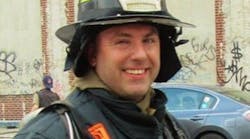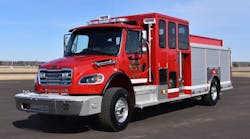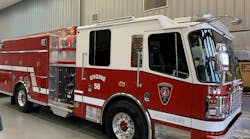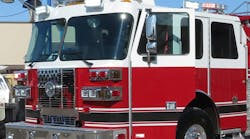Now that I've caught your interest with that attention-grabbing headline, I hope you will continue to read. It is quite a bold headline, yet it is true.
As with all good stories, we should probably start at the beginning. We turn the clock back to February 2006 at Firehouse World in San Diego, CA. The talk of the show was a proposal submitted to the National Fire Protection Association (NFPA) 1901 committee to ban self-contained breathing apparatus (SCBA) from fire apparatus cabs. The submitter advocated a policy adopted by Phoenix and several other fire departments under which all SCBA were removed from seatbacks and moved to high side compartments.
At that time, it seemed like a good idea to me. First, I thought that removing a potential high-pressure projectile from the seatbacks might really make cabs safer. Second, I thought about what happens when we arrive at a fire and the crew members rush out of the cab and into a burning building. Not long before, I had the occasion to ask one of my new firefighters what floor we were on while we were inside at a structure fire. He didn't know. I said to him, "If we get separated and you get lost, how are you going to call me on the radio and tell me where you are?" So reason number two could be that during the extra 30 seconds it takes to get the SCBA out of the compartments, firefighters may have a look at the building and do a quick size-up. That's right — actually take a few seconds to look at the building and the visible fire conditions before going inside. What a novel idea!
I also thought that if we take the SCBA (and probably a bunch of other stuff) out of the cabs, we would make it easier for firefighters to fasten their seatbelts. We had been talking and talking about how to get firefighters to fasten their seatbelts. Maybe this would create a sanitized environment where the emphasis would be on personal safety and arriving at the alarm location in one piece. Maybe removing the SCBA and all those extra straps would help solve the seatbelt problem.
We know that we attract risk takers to become firefighters. We then train them to go into burning buildings and push hard to make that rescue, put out that last room of fire or make that floor above. But when we talk about responding to the fire, we want them to sit down, fasten their seatbelts and focus on arriving at the scene safely. Could something as simple as this proposal help solve our eternal risk-management dilemma?
As we were having a group discussion about this proposal, one of my best friends yelled at me. He had never done that before. "When are we going to stop regulating everything and start holding people accountable for their own actions and for their own personal safety?" he asked. "Taking the SCBA out of the cabs will only make a bad situation worse." He was visibly upset.
He went on to state, quite emphatically, that if we take SCBA out of the cab and put them in high side compartments, the highly motivated firefighters will take them out of the compartments and put back into the cabs — except now they won't have the brackets to hold them in place. Would we be better off having those 20-pound projectiles bouncing around loose in the cabs, ready to launch the instant the apparatus wheels leave the pavement?
Of course, some will argue that this is an enforcement issue, or a supervisory issue, but let's think about how much success we have had enforcing seatbelt rules. Maybe the simple solution isn't as simple as I thought. By the end of that night in San Diego, I had changed my mind. We would have to figure out how to convince firefighters to wear their seatbelts without taking their SCBA out of the cabs.
So, I went back to work at the Cross Bronx Express thinking about why firefighters don't fasten their seatbelts. In a rare moment of supervisory brilliance, I thought of asking my firefighters that question. Their answers were both interesting and compelling.
Danny spoke up first. "Loo, we can't," he said. "They don't work."
Notice that he said, "Loo, we can't," not, "Loo, we won't." The rest of the crew joined in to inform me that the seatbelts just don't work. So, I said, "Fine, let me go get my digital camera and you go get your bunker gear on and then you show me why the seatbelts in our apparatus don't work."
We tried the seatbelts in the engine that were integrated into the seats and then we tried the seatbelts in the ladder truck that were attached to the back wall of the cab. We tried them in the forward-facing seats and we tried them sitting backwards.
Ultimately, they all managed to get the seatbelts fastened around them, but it was far from easy. In several cases, it was nearly impossible. A typical firefighter in full bunker gear could barely squeeze into the seat, then had to twist around to reach the seatbelt and pull, tug and push to get it wrapped around all that clothing and equipment and properly buckled. I began to understand the problem.
I spoke with some firefighter friends about what could be done to correct the problem. I asked them to take pictures of firefighters trying to put seatbelts on in their apparatus. I wanted to see if the same problems existed in other fire departments or if it was limited to just one fire department, one brand of apparatus, one model of cab or one type of seat. We quickly determined that the problem was showing up in numerous fire departments across a wide spectrum of fire apparatus manufacturers. Some were better, some were worse, but we found numerous examples of seats and seatbelt systems that were not "firefighter friendly."
A discussion with my friends brought out the suggestion that we should hold a meeting and invite all of the fire apparatus manufacturers, all of the seat manufacturers, all the seatbelt manufacturers, and any other organization or entity that was interested in the subject. The purpose of the meeting would be to discuss the problem and see who was interested in doing something to solve it.
The meeting was scheduled during the Fire Department Instructors Conference in Indianapolis in April and held under the auspices of the Safety, Health and Survival Section of the International Association of Fire Chiefs (IAFC). The first part of the meeting was a friendly, getting-to-know-you session. Then I described the problem and showed the pictures of firefighters struggling to try to use their seatbelts. Some of the people in the room accused me of trying to make excuses for fire departments and officers who don't have the courage to enforce their own rules. Some just thought I was nuts. There was a lot of finger pointing and playing the blame game until finally cooler heads decided that maybe there really is a problem and maybe we need to work together to solve it.
Over the next few weeks, we started to collect measurements of firefighters and supply the engineers with real data. They quickly began to recognize that some of the design standards, including the seating requirements in NFPA 1901, were based on old data and incorrect assumptions about firefighters and protective clothing. Some cab designs and seating configurations that are popular with the fire service simply don't provide enough room for firefighters to sit comfortably and easily fasten their seatbelts. The standards need to be updated and some designs need to be changed.
It is easy to understand how we got to this point. In a generation, we have gone from riding on tailboards to riding in seats with built-in SCBA in fully enclosed cabs. As this was occurring, firefighters were becoming bigger, taller and heavier; modern bunker gear was invented; pockets were filled with tools and equipment, self-evacuation rope bags were attached; and radio pockets and flashlight straps were added. The apparatus manufacturers are making great trucks, the seat manufacturers are making great seats and the seatbelt manufacturers are making great seatbelts; however, it appears that nobody was bringing all of them together. The engineers would describe it as a systems-integration problem.
So, where are we now with this project? In discussions at a second meeting, which occurred at Firehouse Expo in Baltimore in July, it was determined that two courses of action are needed. The Safety Task Force of the NFPA 1901 Committee is working on developing changes to the standard for the next revision cycle. We are measuring at least 1,000 firefighters, across North America, in what is called an anthropometric study. The measurements are being gathered to figure out what changes are needed to fit modern firefighters into the seats in modern apparatus. This will ensure that the seating in new apparatus is designed to meet realistic requirements. The IAFC's Safety, Health and Survival Section agreed to take the lead in efforts to develop retrofit solutions for existing apparatus. Several apparatus and component manufacturers are already at work trying to engineer new designs.
Obtaining the measurements of 1,000 or more firefighters is only a preliminary step. The initial study is being performed with simple measurement techniques, such as using a tape measure, so that it can be done quickly and easily by fire departments and the data can be reported back to the project team. It was suggested that we also do three-dimensional body scans, using a laser scanner, to get more accurate data, and expand the anthropometric study to include many other safety and size concerns.
It soon became apparent that a lot of related issues were identified. For instance, we know that NFPA standards require 14-inch spacing between the rungs of an aerial ladder. What scientific process was used to determine that 14 inches was the correct rung spacing? The rung-spacing standard has not been updated or even considered in the past 40 years. Is it still valid? The same questions could be asked about dozens, maybe hundreds of other size requirements that may or may not be valid today.
Most of our current equipment is designed to fit the general population, the military or some other group for which anthropometric data was available. Very little of our equipment was specifically designed for firefighter use. A more detailed anthropometric study of firefighters would provide the data to validate many good products that are already available and to improve or develop new products based on solid scientific data.
The National Fallen Firefighters Foundation (NFFF) was instrumental in setting up a meeting with the National Institute for Occupational Safety and Health (NIOSH) at its headquarters in Morgantown, WV. The scientific research group that does anthropometric analysis at NIOSH expressed a serious interest in working with the group that performs firefighter fatality investigations to conduct a detailed study of firefighters. It was determined that a pilot study should be conducted with three-dimensional laser scanning of between 160 and 200 firefighters. It was also suggested that a range-of-motion study be conducted at the same time.
The pilot project would be the foundation for a full-blown study that would include laser scanning and range-of-motion measurements of over 1,000 firefighters. This project would probably take at least three years to complete.
What does this mean for you and me as line firefighters? There is a potential for the data gathered from this study to impact every facet of firefighter safety for decades to come. Imagine apparatus that we can fit into, seatbelts that are user friendly, steps to fit the boots that we wear and handrails placed on apparatus where we can actually reach them. Think about bunker gear that would fit better and flex easily where we need to bend, gloves that would actually fit and ladders that would be easier to climb.
This is truly an exciting time in the fire service. Everyone involved really wants to help make firefighting safer and the level of cooperation among all the groups involved, including IAFC, NFFF, NFPA, NIOSH and the Fire Apparatus Manufacturers Association (FAMA), has been outstanding.
With all of this said, the fact remains that you must fasten your seatbelt. No excuses! None! Even if it is difficult, it is important. Using the seatbelts we have now is absolutely better than not wearing any seatbelts at all. Just ask the two departments in the past month where firefighters became projectiles and were ejected out of fire apparatus. One firefighter had her arm trapped under the truck for over 15 minutes — and she was the lucky one.
As we continue through this process, I will update you through this column as events warrant. For more frequent updates, please visit my website at www.emergencyvehicleresponse.com.
MICHAEL WILBUR, a Firehouse® contributing editor, is a lieutenant in the New York City Fire Department, assigned to Ladder Company 27 in the Bronx, and has served on the FDNY Apparatus Purchasing Committee. He consults on a variety of apparatus-related issues around the country. For further information, access his website at www.emergencyvehicleresponse.com.





